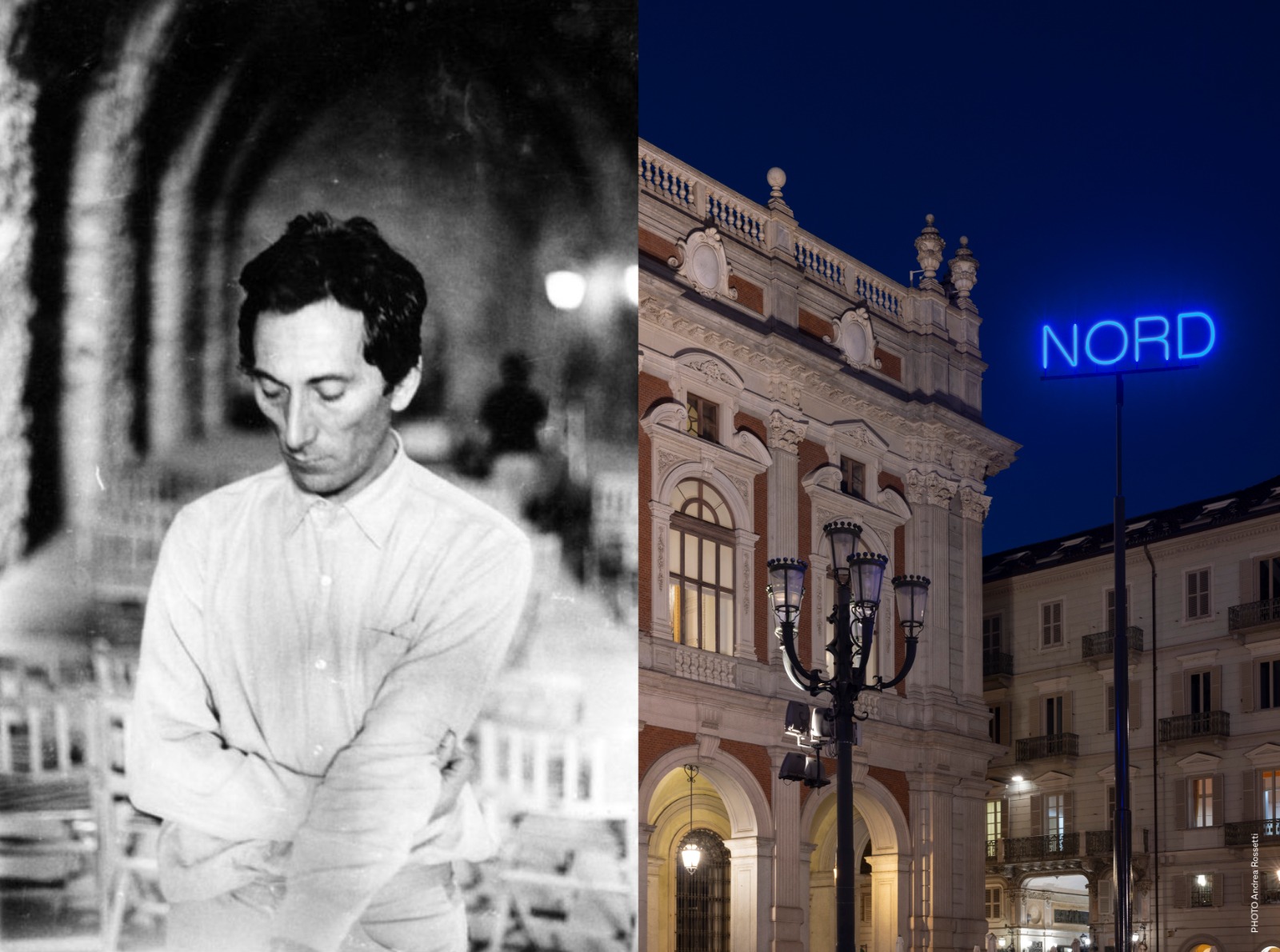
27 OCT 23
14 JAN 24
26TH EDITION
TORINO
Luci d'Artista reaches its 26th edition. Every year, during the winter period, the City of Turin is transformed into an open-air museum of light installations by great Italian and international artists. The Luci were born in 1998 as exceptional illuminations to celebrate the Christmas festivities, and immediately became the object of an ambitious objective: to create a public collection expressing "a high culture capable of communicating with everyone", as Fiorenzo Alfieri, its visionary creator, put it.
But every project, in order to continue to be alive, needs to evolve. This is why Luci d'Artista, starting this year, is beginning a process of mutation of its identity to become a true institution dedicated to contemporary art, one that is even more loved and known, open and sustainable, active all year round and not only during the winter months, with continuous communication with its public and a new, rich and detailed website.
— Antonio Grulli, Luci d'Artista curator
DOWNLOAD MAP
LUCI D'ARTISTA
-
1
Cosmometrie (2002)
Mario Airò
Piazza Carignano (Circ. 1)
38 LED projectors with engraved slides, polycarbonate structure, steel poles, PLC control unit.
DISCOVER
Mario Airò’s Cosmometrie are symbolic and geometric schemes designed to be projected onto the ground, taken from the work Articuli 160 adversus mathematicos by Giordano Bruno (1548-1600). What interests the artist is the speculative and not just mathematical approach that characterised the theologian’s geometric investigations. In his works, Airò often refers to the literary and philosophical tradition, as was already the case with Welcome to my monastery (1997), in which, starting from Ernest Hemingway’s novel Islands in the Stream, he reflected on the work of Pontormo, Ezra Pound, El Greco and Hölderlin. As in many of his works (Notti e nebbie, 1998, or La nebulosa di Orione, 2002), the projectors and other instruments used are not concealed but exposed in their own right: the coexistence of technology and references to historical sources evokes an atmosphere that is both evocative and ambiguous.
Making his debut in the art scene in the 1990s, Mario Airò (Pavia 1961) was one of the founders of the magazine “Tiracorrendo” and of the exhibition space in via Lazzaro Palazzi in Milan. He participated in exhibitions such as the Quadriennale in Rome and the Venice Biennale (in 1996 and 1997) and in 2001 the GAM in Torino dedicated a solo exhibition to him. Some of his works belong to important public collections such as the Galleria Nazionale d’Arte Moderna in Rome, the Castello di Rivoli and GAM itself.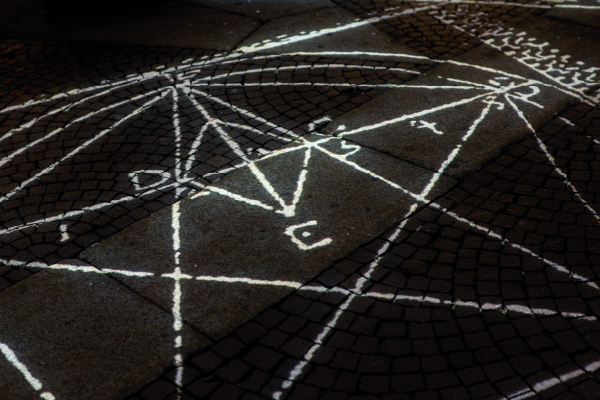
Ph. Riccardo Rebora
Txt. Silvia Maria Sara Cammarata -
2
Orizzonti (2023)
Giovanni Anselmo
Piazza Carlo Alberto (Circ. 1)
Orizzonti (Horizons) is the title of Giovanni Anselmo’s installation: it is made up of 4 blue lights that represent the words North, East, South and West, the 4 cardinal points. All the lights are visible at the same time from the center of the square, so as to allow anyone passing by to orient themselves, seeking their own direction in the space. By indicating the cardinal points starting from the exact center of Piazza Carlo Alberto, the artist connects a place in Turin with a wider, global, geographical and ultimately cosmic space. The spectator, as well as the casual passerby, will in this way have the opportunity to go “beyond” the mere spatial and historical data in which they find themselves living at that moment, finding and redefining their own horizon.
DISCOVER
The installation interacts with the layout of the city, repositioning it and showing, in a subtly disturbing way, how the claimed orthogonality of a big part of the urban plan is actually out of phase with respect to the cardinal points. Through Anselmo’s works you can feel the world taking position under your feet, and the body becomes physically and mentally aware of eternal and immutable elements, as in the case of historical works in which the magnetic needle of the compasses indicating the north is used. The artist directly presents the energies of the cosmos and of life, staging them, exposing them and not representing them, and making concepts such as gravity, balance and the forces of nature visible. Light, in this process by which the invisible is made visible, takes on a fundamental role and becomes the material of choice.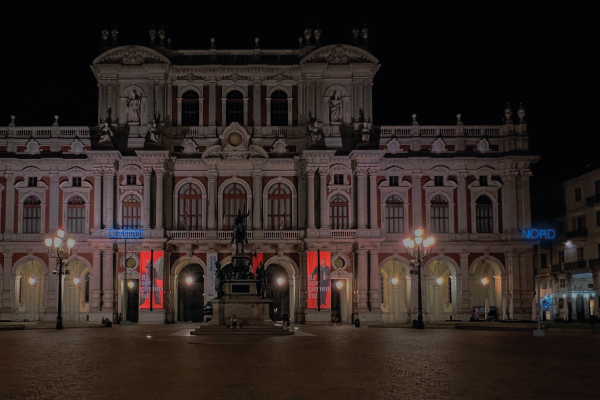
Txt. Antonio Grulli -
3
Vele di Natale (1998)
Vasco Are
Piazza Bodoni (Circ. 1)
Wood, LED neon flex, light bulbs, wire mesh, coloured plexiglass fragments and bronze and brass bells.
DISCOVER
Vele di Natale (Christmas Sails) consist of triangular wooden frames with a wire mesh where bells and coloured plexiglass fragments that refract light, are attached to. The tubes of green bulbs along the edges are reminiscent of Christmas trees, and the sound of the bells creates a fairy-tale effect that, in the artist’s intentions, also recalls the image of kites or the grease pole game.
The poet Nico Orengo recounted his friend Vasco Are’s (Castelletto Stura, Cuneo 1943-2001) love of puns, and it is no coincidence that the title of the work presents an ambiguity: not “trees”, but “sails”. For Are, the sails recall the adventurous imagery of Emilio Salgari and Robert Louis Stevenson, pirates and Vikings.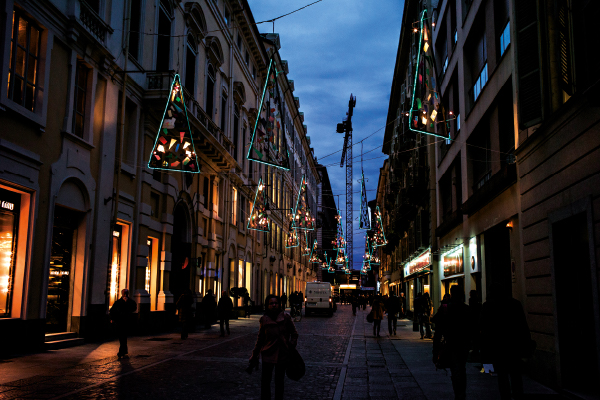
Ph. Andreis Enrico
Txt. Silvia Maria Sara Cammarata -
4
Ancora una volta (2012)
Valerio Berruti
Via Monferrato (Circ. 8)
Aluminium and wire mesh frames, LED micro-lights and LED flex neon.
DISCOVER
Ancora una volta (Once Again) is composed of 10 elements that, like luminous photograms, light up one after the other and then remain lit simultaneously for a few moments, in a sequence reminiscent of the techniques for creating animations, a process dear to Valerio Berruti. It is precisely this sequence that provides the image with the necessary mobility to evoke the leaps of a child’s game that takes place over the heads of passers-by, with whom the profile of the crouching child seems to interact.
The work of Berruti is populated with childlike figures drawn with few strokes, leaving out details to bring out the simplicity of forms. Sometimes depicted alone, these figures often appear in family groups, so much so that critic Marco Meneguzzo has spoken of “bourgeois anthropology”, not least because of a certain sense of nostalgia that his works arouse.
His childhood-related imagery, initially expressed in painting and drawing, then developed into sculpture and the language of film, with video and installation projects such as La giostra di Nina (MAXXI, Rome, 2019) and then extended to an environmental and urban scale.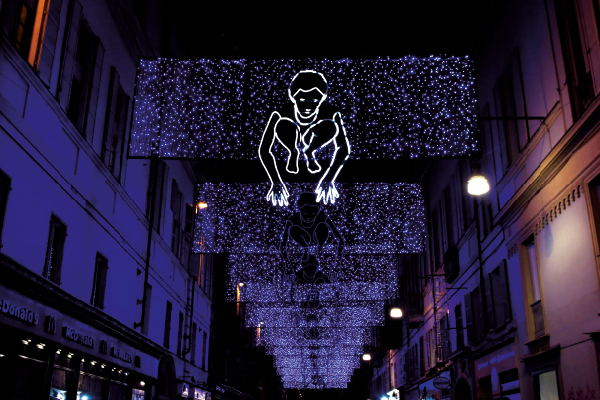
Ph. Fabio Castaldi
Txt. Silvia Maria Sara Cammarata -
5
Tappeto volante (1999)
Daniel Buren
Piazza Palazzo di Città (Circ. 1)
Steel cables and frames, plexiglass cubic lanterns, adhesive film.
DISCOVER
The Tappeto volante (Flying Carpet) consists of 1536 cubic Plexiglas lanterns coloured in red and blue alternating with white, in the 8.7 cm strips that characterise all of Daniel Buren’s works, regardless of their size and location.
Since 1965, Buren has in fact abandoned traditional painting techniques to devote himself to minimalist and conceptual style. Since then, he has used the strip: a deliberately banal and anonymous sign that avoids subjective elements and takes on the form of a radical act: a “visual tool” that allows the observer to focus not only on the object, but on the relationship, it has with the place that hosts it. The work thus becomes a sign of attention to the context.
In past editions of Luci d’Artista, Tappeto volante had been set up in other locations of the city centre, and on the occasion of the 2006 Winter Olympics in Turin, it was modified by substituting green for blue to celebrate the colours of the Italian flag.
Daniel Buren (Boulogne-Billancourt, 1938), is one of the most internationally acclaimed contemporary artists, already awarded the Golden Lion for Lifetime Achievement at the Venice Biennale in 1986. His rigorous research is developed in different media and on an environmental scale with interventions in public space and permanent works such as the installation in the court of honour of the Palais Royal in Paris, with 260 octagonal columns that extend underground or, in Piedmont, the 126 floating flags that dialogue with the landscape from the terraces of the Zegna Foundation in Trivero, near Biella.
Ph. Riccardo Rebora
Txt. Silvia Maria Sara Cammarata -
6
Volo su… (1998)
Francesco Casorati
Via Garibaldi fino a piazza Statuto (Circ. 1)
Aluminium, steel, LED neon flex.
DISCOVER
Volo su... (Flight over…) is composed of 52 stylised birds represented in four different poses, two in flight and two with their legs visible, distributed in succession along an imaginary zigzag trajectory, while holding in their beaks the same long red thread that from via Garibaldi, the site of the original location, ends up wrapping around the monument to the Caduti del Fréjus (Fallen of the Fréjus tunnel) in piazza Statuto. It is a work that well represents the artist’s poetics, in which the geometric outline of the birds is combined with a fairy-tale intonation and the bright red thread represents a path that unites them and, like Ariadne’s thread, shows passers-by the road to harmony.
Francesco Casorati was active from the second half of the 1950s among the Turinese artists who gathered around Francesco Tabusso’s “Orsa Minore” magazine, developing his individual journey but in constant dialogue with contemporary artistic currents. The son of Felice, one of the major protagonists of Italian art in the first half of the 20th century, and the English artist Daphne Maugham who had initiated him into painting and the piano, Francesco Casorati, despite his differences, had inherited from his father an approach to painting that did not originate from the impression but from the idea, and that also influenced his rich production of engravings. His imagery is rooted in the world of childhood and is populated by recurring subjects such as birds, fish, cages and ships, often depicted in a style in which simplification and formal rigour are combined with a strong lyricism.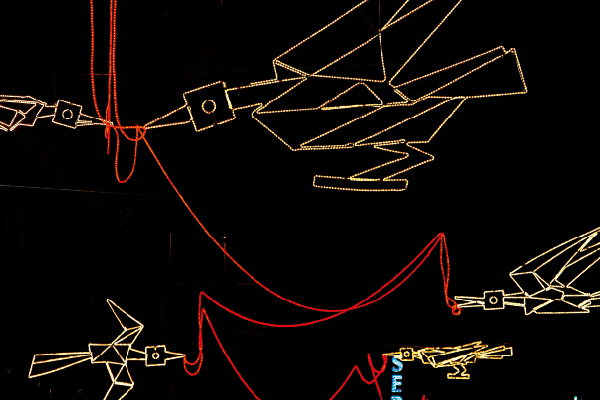
Ph. Guido Ottolenghi
Txt. Silvia Maria Sara Cammarata -
7
Regno dei fiori: nido cosmico di tutte le anime… (2004)
Nicola De Maria
Piazza Carlina (Circ. 1)
Iron structures, coloured adhesive film, lexan sheets, fibre optic and speed-adjustable illuminators.
DISCOVER
Nicola De Maria created Regno dei fiori: nido cosmico di tutte le anime (Kingdom of Flowers: Cosmic Nest of All Souls) by intervening on the existing street lamps in piazza Carlo Emanuele II, around which he wrapped tubular metal elements with fibre optic threads hooked on them, reflecting the light like a luminous hank, evoking the image of a nest.
The title Regno dei fiori, which appears several times in De Maria’s research, reflects the artist’s “cosmic” ambition to embrace all possible worlds within his work, making the transcendent visible, in a quest for harmony laden with spiritual components. His pictorial production, declined in large formats that are often developed on an environmental scale covering walls and ceilings, is characterised by a strong lyrical tension that also finds expression in the titles or phrases drawn in fine handwriting that sometimes appear on the painting. Words and signs refer to an inner dimension that engages in dialogue with the absolute, giving shape to an entire linguistic system, almost a grammar of elementary forms and bold colours, under the banner of a rediscovered innocence.
Nicola De Maria took part in Transavanguardia, the group formed by critic Achille Bonito Oliva in 1979 that, in the context of the emerging postmodern culture, expressed a renewed interest in painting and traditional art techniques.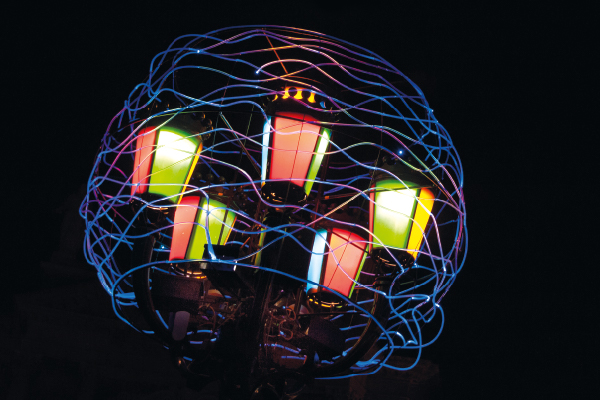
Ph. Renzo Miglio
Txt. Silvia Maria Sara Cammarata -
8
L’energia che unisce si espande nel blu (2009)
Marco Gastini
Galleria Umberto I (Circ. 1)
Aluminium frame, steel cables, LED flex neon.
DISCOVER
As the title suggests, the protagonist of this work by Marco Gastini is energy, the central theme of his artistic career. In a conversation with art historian Bruno Corà, Gastini explained his work as the need to “touch the energy within the materials and make it become painting, to capture the tension and put it on the canvas.” His Light, L’energia che unisce si espande nel blu (The Energy that Unites Expands in Blue), is thus configured as a large luminous painting mainly in shades of blue, to which Gastini attributed a special energy, evoking “Klein or Giotto blue”.
Gastini trained at the Accademia Albertina in Torino and prior to that, at his father’s marble workshop. He started his research in the 1960s, driven by the need to move beyond the late Informal, initially arriving at the definition of a painting of minimal marks and gestures, which then expanded, fragmented, in tension with space.
With an extensive exhibition activity in Italy and abroad, Gastini participated in the Venice Biennale on two occasions, in 1976 and 1982. In 2001, the GAM in Torino dedicated a major retrospective to him, curated by Pier Giovanni Castagnoli and Helmut Friedel, which was later staged at the Lenbachhaus in Munich.
Ph. Riccardo Rebora
Txt. Silvia Maria Sara Cammarata -
9
Planetario (1998)
Carmelo Giammello
Via Roma (Circ. 1)
Aluminium, nylon mesh, polycarbonate, neon replaced with LED neon flex in 2019 when the work was rebuilt, light balls.
DISCOVER
Carmelo Giammello’s Planetario (Planetarium) consists of 34 structures presenting various types of constellations. From scientific loyalty and creative invention, only some of them are recognisable, such as Ursa Major, Ursa Minor or the Centaurus, while others simply respond to the artist’s drawing. The project originally also included the realisation of a three-dimensional globe, which was shelved during construction. After studying scenography at the Accademia Albertina, Carmelo Giammello was in charge of stage design at the Teatro Stabile di Torino from 1989 to 2002, while also working in other projects and alongside some of the best- known directors and playwrights, from Massimo Missiroli to Dario Fo, from Ugo Gregoretti to Giancarlo Sepe. In 1994, he collaborated with Gae Aulenti on the opera performance Elektra for Teatro Alla Scala in Milan.
His installation work and consequent sensitivity to interventions in space are also reflected in his Luce (light) in Torino.
In 2004, Giammello won the Gassman and Ubu Prizes with the set design of Molière’s The Miser.
Ph. Renato Longo
Txt. Silvia Maria Sara Cammarata -
10
Migrazione (Climate Change) (2015)
Piero Gilardi
Galleria San Federico (Circ. 1)
Frame, steel cables and LED flex neon.
DISCOVER
The installation Migrazioni (Climate Change) consists of 12 silhouettes of pelicans that, following an algorithm developed by Piero Gilardi with videomaker Heinrich Vogel, light up and go out one after the other, alternating the colours blue, purple, red and yellow that recall the sunset. As the title suggests, the flock flies in search of more favourable climates.
Best known for his Tappeti natura (Nature carpets), which since 1965 bear witness to his precocious sensitivity to environmental themes, Piero Gilardi has embodied the figure of the militant artist from the very beginning.
He was a member of Arte Povera, but as early as 1968 he chose to abandon his artistic practice to devote himself to the theoretical elaboration and activation of networks and exchanges between artists. He was in fact one of the protagonists of the Deposito d’Arte Presente and with his travels between Europe and the United States he aimed to bring artists together, imagining their potential self-management and contributing to the conception of two epoch-making exhibitions such as “When Attitudes Become Form” (Kunsthalle in Bern) and “Op Losse Schroeven” (Stedelijk Museum, Amsterdam), both in 1969.
In the 1980s he embraced New Media Art with the idea of exploring new possibilities of social coexistence and sharing, and in the following decade he created interactive multimedia installations as part of an intense international activity. In 2006 he founded the PAV - Parco d’Arte Vivente di Torino, which he describes as “an incubator of ecological civic consciousness” and for which in 2018 he created another light installation entitled L’albero del PAV (The PAV Tree). In 2017, MAXXI in Rome dedicated a major retrospective to him.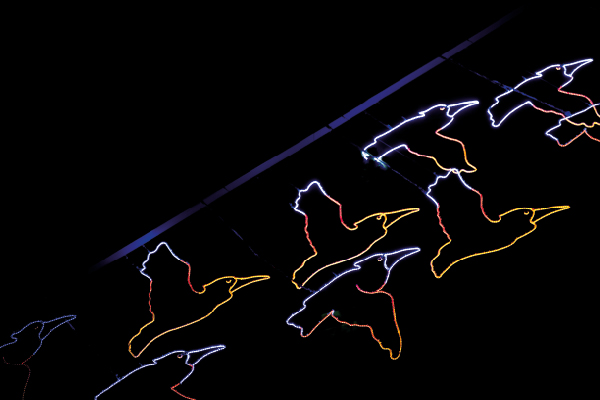
Ph. Forino Guido
Txt. Silvia Maria Sara Cammarata -
11
AZZURROGIALLO (2022)
Giorgio Griffa
Giardini Sambuy, piazza Carlo Felice (Circ. 1)
Steel cables and terminals, nylon ropes and cables, aluminium frame, LED micro-lights, LED flex neon, steel poles and concrete plinths.
DISCOVER
A dynamic electric blue stream floats around yellow eddies: Giorgio Griffa’s installation fits with magical force into the frame of the Giardini Sambuy, profoundly altering the perception of the place. The artist has explained the motives that have “accompanied” him in this new experience: the thought of the unstable physical universe, of life, of elementary particles, an “immense indeterminate energy” in continuous transformation; a flow of energy like the flow of water. After a lifetime of work and research with the traditional tools of painting - paint, canvas - Griffa tackled light, aerial and environmental space. The artist’s work has always been the result of extreme concentration, at the beginning as well as in the later stages, with his extensive study of Matisse and the great theme of decoration, almost as a private matter... now he has faced the inevitable clash with the viewer, even the viewer whose gaze is not used to measuring himself against the work of art. New technique, new tools. The result is a work that is both dry and sumptuous, almost festively redundant compared to many past achievements. A luminous epiphany, with an irresistible allusion, not denied by the artist, to certain starry nights of Van Gogh’s paintings.
Giorgio Griffa is present with important artworks in the GAM-Torino Collection and in many Italian and foreign museums. He has an intense national and international exhibition career of over 150 solo exhibitions and in 2022, he has been celebrated by a retrospective at the Center George Pompidou in Paris.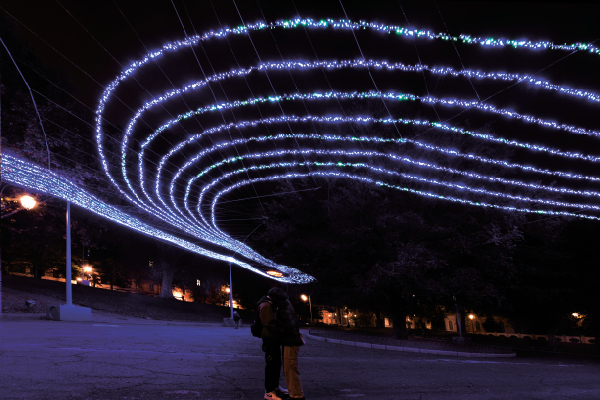
Ph. Renzo Miglio
Txt. Riccardo Passoni -
12
Illuminated Benches (2005)
Jeppe Hein
Piazza Risorgimento (Circ. 4)
Modular metal structures, LED flex neon, sensors, coloured plastic laminate panels.
DISCOVER
Illuminated Benches is an installation consisting of twelve benches arranged to form two horseshoes. The weight of the person leaning on it causes the long neon bars placed horizontally under each seat to light up, illuminating the underside of the bench in pinkish white, yellow, red, ice blue, blue or green.
Jeppe Hein thus makes the benches a relational and interactive object: when they are not lit they blend in with the others, but when they are lit they expose the choice of relationship between the different seated subjects, marking their distribution and proximity. Similarly, one person illuminating a bench makes one’s momentary loneliness more apparent.
“My art should be a means of communication and interaction between visitor, work and space that can change people’s idea of their expectations of art,” Hein explains. Direct involvement thus helps the spectator, sometimes unaware of relating to a work of art, to overcome the passive contemplation typical of museums, without having to overcome any social or language barriers.
Interaction and participation are at the core of Jeppe Hein’s work who, since the late 1990s, has created works for public spaces in different parts of the world and exhibited in some of the world’s best-known museums.
His Modified Social Benches (benches shaped to create multi-level seating, often with slides) were set up in the Giardini at the Venice Biennale in 2019 and in 2022 the Moderna Museet in Stockholm dedicated a major solo exhibition to him entitled “Who are you... really?”
Ph. Giulio Penna
Txt. Silvia Maria Sara Cammarata -
13
Piccoli spiriti blu (1999)
Rebecca Horn
Monte dei Cappuccini (Circ. 8)
Steel poles, rods and cables, LED neon flex and projectors.
DISCOVER
Piccoli spiriti blu (Little Blue Spirits) is composed of 72 circles of blue lights of different sizes, initially installed around the Gran Madre church, and then moved to Monte dei Cappuccini, where they surround the church, extending to a wing of the former convent. In both locations, the work contributes to changing the perception of space by creating an atmosphere of suspension with unreal tones. If before it was the aura of mystery that some attribute to the Gran Madre, it is now the fog on the Torino hill that amplifies the effect.
The energy that springs from the places is at the centre of other light installations created between the 1990s and 2000s, such as Spiriti di madreperla (Mother-of-pearl spirits), in piazza del Plebiscito in Naples, where white luminous rings suspended above cast-iron skulls emerging from the ground defined an energy field between earth and sky, evoking life facing eternity.
Rebecca Horn works with different languages and media. In her early performances in the 1970s, she investigated the relationship between body and space through “bodily extensions”, structures and masks to be worn, which were soon replaced by complex mechanical devices, kinetic machines that initially appeared in her films, and interact with the environment through elements and objects such as mirrors, funnels, feathers.
Between the 1980s and 1990s, Horn created site-specific sculptures in places charged with political and historical meaning. In her universe of materials and forms rich in metaphorical and symbolic references, there is also the power of writing.
Rebecca Horn has had solo exhibitions in museums such as the MOCA in Los Angeles, the Guggenheim in New York, and the Tate Modern in London, and has won several awards, including the documenta Prize (1986) and the Praemium Imperiale of Tokyo (2010).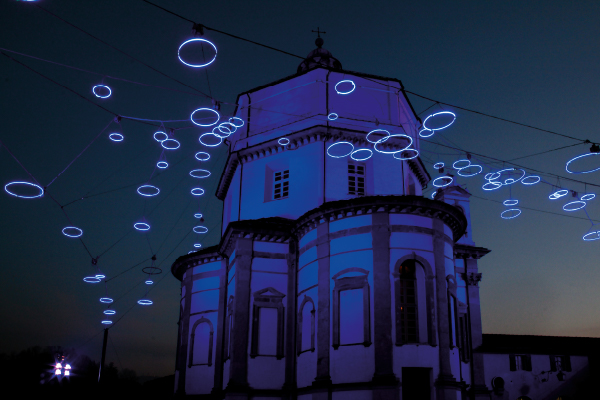
Ph. Rita De Nardi
Txt. Silvia Maria Sara Cammarata -
14
Cultura=Capitale (2013)
Alfredo Jaar
Museo della Resistenza (Circ. 1)
Neon and supporting frame.
DISCOVER
Cultura=Capitale (Culture= Capital) is the luminous equation that Alfredo Jaar wanted to produce to leave a message as simple as it is unequivocal: a slogan conveyed
through the careful reading of the pages of Antonio Gramsci, Pier Paolo Pasolini and Nanni Balestrini, who are important points of reference for the artist. “The spaces of art and culture are the last to remain free, which is why they are precious. Culture is our real capital,” Jaar explains. Artist, architect and film maker, Alfredo Jaar (Santiago de Chile, 1956) has lived and worked in New York since 1982, but trained in Chile oppressed by the censorship of Augusto Pinochet’s regime. Believing in the importance of the role of the artist, who can propose “models for thinking about the world”, Jaar creates conceptual works and public interventions that speak to individual conscience.
He has participated in five editions of the Venice Biennale (1986, 2007, 2009, 2013) and other major international exhibitions such as the São Paulo Biennale or documenta in Kassel. His works, which earned him the Guggenheim Fellowship (1985), the Mac Arthur Fellowship (2004) and the Premio Extremadura a la Creación (2006), have been exhibited in some of the most important international collections.
Ph. Claudio Pastrone
Txt. Silvia Maria Sara Cammarata -
15
Doppio passaggio (2001)
Joseph Kosuth
Ponte Vittorio Emanuele I (Circ. 1)
Neon, support frames and DMX control system.
DISCOVER
The neon lettering of Doppio passaggio (Double Passage) reproduces two excerpts from Invisible Cities by Italo Calvino and Thus Spoke Zarathustra by Friedrich Nietzsche. Of equal length and placed opposite each other, both texts develop the metaphor of the bridge as a vehicle of communication.
Joseph Kosuth is one of the pioneers of conceptual art and has focused his research on language, questioning the very nature of art.
Kosuth’s work is thus proposed as a semiotic investigation into the rules of representation and the relationship between concepts and the words used to express them, recording the shifts in meaning that every representation implies and often using tautology and quotations, as is the case with the Light in Torino, conceived for the Vittorio Emanuele I bridge.
Joseph Kosuth has participated in eight editions of the Venice Biennale, receiving an honourable mention in 1993, and in seven documenta in Kassel. His many awards include being appointed Chevalier de l’Ordre des Arts et des Lettres by the French government (1993), an Honorary Doctorate in Philosophy and Letters from the University of Bologna (2001) and an Honorary Doctorate from the University of Havana (2015). His works are in the collections of the world’s most important museums.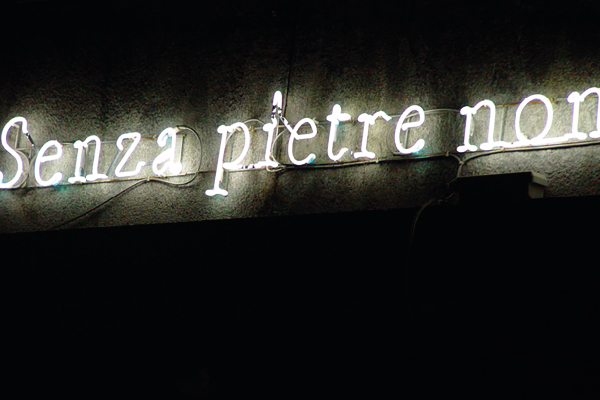
Txt. Silvia Maria Sara Cammarata -
16
io, sono nato qui. (2022)
Renato Leotta
Ospedale Sant’Anna, corso Spezia (Circ. 8)
Neon, aluminium support frame and DMX control system.
DISCOVER
io, sono nato qui. (me, I was born here.): the white neon cursive appears on the roof of the Sant’Anna Hospital of Obstetrics and Gynaecology in Torino in a discreet but legible size. Leotta was indeed born at the Sant’Anna Hospital and this makes the work a context-specific and very personal project. But it is also a reminder of the status of the subject more generally, at a time when not only the artist must come to terms with the feeling of his own minority in relation to the gigantic numbers of communications, social media and followers, but also every passer-by, in a car or on foot, can stop at this place along the Po River and experience a poetic moment of awareness of his or her own fragile existence: they too have spent a few hours or days at the time of their birth in an almost anonymous place like this hospital. The artwork is therefore a hymn to what remains of the individual and singular person in an algorithmic age of perceived passivity in the face of technology, as well as being an image, in that pause marked by the comma after the word “I”, of the melancholic and hysterical mass narcissism - of those who frantically post their selfies and data in search of feedback and recognition. An artist who uses a variety of media and materials, of conceptual and Arte Povera legacy, Leotta was born in 1982 in Torino and lives between Sicily and the city his parents adopted in the 1970s during a tailspin of the industrial boom era. He is among the most emerging young Italian artists also internationally and has exhibited at Manifesta 12 in Palermo in 2018, at the Castello di Rivoli in 2020 and at the 17th Istanbul Biennale in 2022.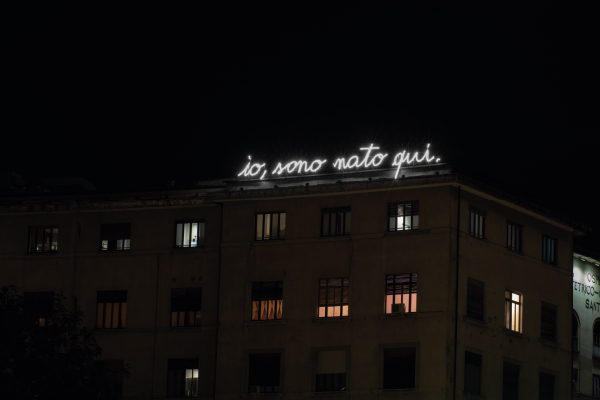
Ph. Pellion
Txt. Carolyn Christov-Bakargiev -
17
Luì e l’arte di andare nel bosco (1998)
Luigi Mainolfi
Via Lagrange (Circ. 1)
Aluminium profile frame and LED neon flex tubes.
DISCOVER
Luì e l’arte di andare nel bosco (Luì and the Art of Going to the Woods) is a short story by writer Guido Quarzo that Luigi Mainolfi has divided into 47 sentences written in the form of illuminated signs, to be read while walking. It is the story of the madman Luì who manages to rescue children and other people lost in the forest thanks to his ability to invent objects that make noise and to create sculptures by carving wood found along the way. The protagonist of the story is thus presented as an alter ego of Mainolfi, a sculptor engaged in the creation of sound works such as bells and castanets.
Mainolfi moved to Torino in 1973 after studying at the Academy of Fine Arts in Naples and made his debut in the 1970s with installations and exhibitions in which he presented plaster casts of his own body. During the same period, he worked on the more theoretical aspects of sculpture with a series of drawings and writings, then developed a personal language that drew on the values of material culture and an imagery that combined the archaic and the poetic and fable-like dimensions. In the 1980s, he came to the attention
of critics with works made from earth-related materials such as tuff, terracotta and lava stone. Internationally renowned, he exhibited at documenta in Kassel in 1982 and at the Venice Biennale, which dedicated a solo room to him in 1990. His numerous exhibitions include his participation in 1986 in Ouverture II, the second exhibition of the Museo d’Arte Contemporanea del Castello di Rivoli curated by Rudi Fuchs, and the 1995 anthological exhibition curated by Pier Giovanni Castagnoli and Riccardo Passoni at the Società Promotrice di Belle Arti.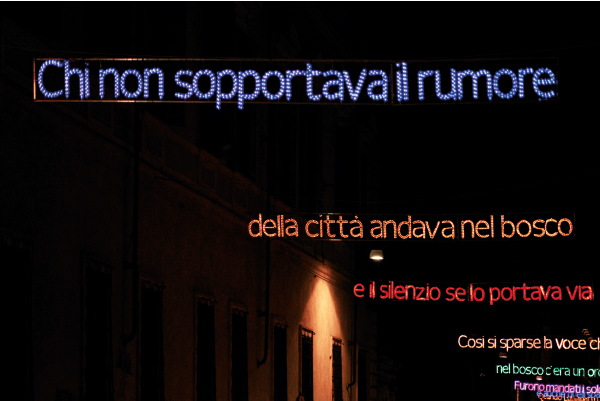
Ph. Alessandro Munari
Txt. Silvia Maria Sara Cammarata -
18
Il volo dei numeri (2000)
Mario Merz
Mole Antonelliana (Circ. 1)
Neon, aluminium support frames, steel cables and DMX control system.
DISCOVER
Mario Merz’s Il volo dei numeri (The Flight of Numbers) consists of a neon reproduction of the first sixteen numbers of the Fibonacci series, the mathematical sequence identified by Abbot Leonardo of Pisa in 1202 and which mathematicians and scientists have since verified to be a recurring pattern in nature. Its geometric transposition, which governs the development of various animal and plant life forms, gave rise to the golden ratio, which has fascinated artists and intellectuals throughout the centuries.
The atavistic marriage of nature and culture, embodied in this series of figures, reflects the poetics of Mario Merz, who placed industrial materials alongside natural ones such as fruit, bundles or wax in his works, often entrusting the luminous energy of neon with the expression of an idea of the continuous transformation of reality, crossed by a vital flow of physical and imaginative charges.
Il volo dei numeri was created and donated by the artist to the City of Torino on the occasion of the coerenza in coerenza exhibition held at the Mole Antonelliana in 1984, and since 2000 it has been part of the Luci d’Artista event.
One of the most internationally recognised Italian artists, Merz, whose death this year marks the twentieth anniversary, participated in the Arte Povera movement and is particularly known to the general public for his Igloos, to which a major retrospective was dedicated at the Hangar Bicocca in Milan in 2018-2019. The political sensibility that had already prompted him, in his early twenties, to join the anti-fascist group Giustizia e libertà and thus be arrested, underlies some of his most famous works such as l’Igloo di Giap (Giap’s Igloo) (1968), which bears the neon inscription of a quotation from the Vietnamese general. There is no lack of painting in his career, to which he owes his debut and which he has continued to practise in an environmental and installation style. Merz has received numerous awards, the last of which was the Praemium Imperiale for Painting in Tokyo in 2003.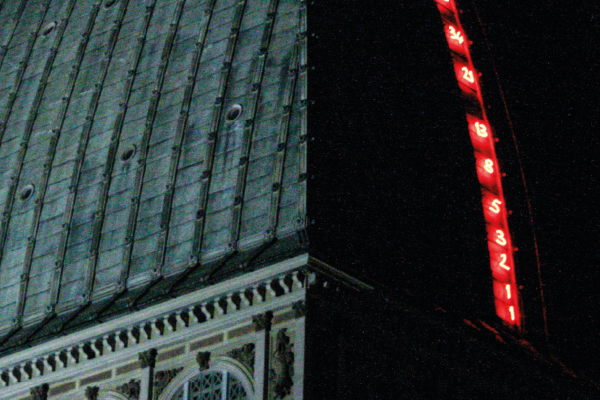
Ph. Riccardo Rebora
Txt. Silvia Maria Sara Cammarata -
19
Concerto di parole (1998)
Mario Molinari
Piazzale Polonia (Circ. 8)
Painted expanded polystyrene blocks, wire rods and spotlights. Rebuilt in 2022, steel truss supporting structure, painted sheet steel cladding, LED floodlights.
DISCOVER
Concerto di parole (Concert of Words) consists of four blocks of geometric solids made of expanded polystyrene, painted in bright colours. Massive in appearance but light in fact, accompanied in some editions by festoons in the form of triangles and stylised little men, these solids are the meeting point of a quest that fuses rigour and fantasy.
A firm believer in an art that is easy for everyone to understand, Mario Molinari adopted the immediate and familiar language of geometry and of primary and secondary colours, earning himself the nickname of “sculptor of colour”, as stated on the plaque that the City of Torino dedicated to him near his home-studio in via Saluzzo.
Part totem, part oversized toy construction, the solids of Concerto di parole look, as Francesco Fanelli has written, to the second futurism and specifically to the work of Fortunato Depero.
Molinari made his debut in the 1960s and, a pupil of Raffaele Ponte Corvo, with him and other artists such as Abacuc, Alessandri and Colombotto Rosso was one of the founders of the Turin neo-surrealist group Surfanta. He initially made copper sculptures with an anthropomorphic appearance before turning to experiments on plexiglass and wood and finally arriving at large, brightly coloured concrete installations, often intended for public spaces. Concerto di parole was in fact reconfigured in concrete in a permanent form in a green area facing the Regina Margherita Children’s Hospital.
After his debut in 1967 at the Gian Ferrari Gallery in Milan, Molinari exhibited in Italian and foreign galleries and in 2004 the Peano Foundation in Cuneo dedicated a retrospective exhibition to him.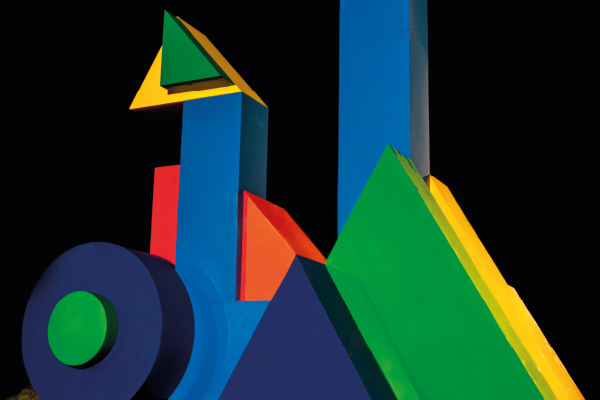
Ph. Glauco Poggioli
Txt. Silvia Maria Sara Cammarata -
20
Vento solare (2004)
Luigi Nervo
Piazzetta Mollino (Circ. 1)
Steel tubes, LED neon flex, concrete blocks, wire mesh, plywood, reflective paint, spotlights. For Vento solare, aluminium profiles and LED light tubes in different colours for the sun’s rays and a new metal support structure are added.
DISCOVER
Il bosco dei maghi (The Magicians’ Forest Solar Wind) is the light installation that Luigi Nervo presented for Luci d’artista, starting with the first edition in 1998. It consisted of twelve bas-reliefs representing the signs of the zodiac, in the usual zoomorphic iconography, painted in reflective orange paint and accompanied by fifty stylised trees outlined with neon lights. For the 2001 edition, Nervo added another bas-relief depicting the sun, and chose to call it Vento solare. The words that the artist uses to speak about the scientific concept he was fascinated by date back to this work.
When, for conservation reasons, it was no longer possible to exhibit Il bosco dei maghi, the same bas-relief of the sun became the centrepiece of the new work created by Nervo, Vento solare, which takes the form of a sun shining its luminous neon rays on the profile of the bas-relief of the moon, added at this stage.
Nervo debuted as a designer in the mid-1950s and taught sculpture at the Accademia Albertina from 1973 to 1998. He is best known for Machines/games such as the Dinosaur in Michelotti Park in Torino, which have been set up in various Italian cities. In 1984, he founded the Teatro d’Automi and during the same period he built set designs for the Teatro Stabile in Torino and Trieste and for the Opera in Rome. After an exhibition at the G30 gallery in Paris, he exhibited in many galleries in Turin and set forth a method of manual skills in the Guida al gioco creativo (Guide to creative play), published in 1982.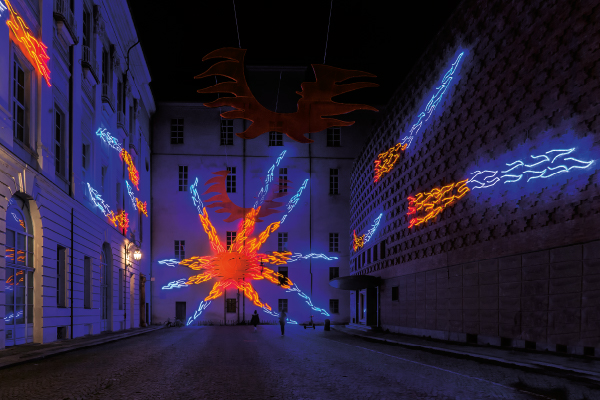
Ph. Claudio Pastrone
Txt. Silvia Maria Sara Cammarata -
21
L’amore non fa rumore (1998)
Luca Pannoli
Parco Michelotti, nel prato fronte Biblioteca Geisser (Circ. 8)
Double-sided silhouettes in screenprinted methacrylate, glass neon and LED neon flex, aluminium and concrete plinths.
DISCOVER
Domenico Luca Pannoli’s Luce (Light) consists of 37 luminous panels imitating road signs and some famous commercial brands, such as the symbol of a smile instead of a no-parking sign or the words “Love” in the middle of the Esso logo. Between arrows pointing to the future and symbols of peace, stands the inscription that gives the work its title. The effect of astonishment sought by Pannoli increases when the components of the work are distributed along a street and can more easily be mistaken for normal street signs from a distance, while the invitation to harmony becomes almost literal in cases where the components of the work are concentrated and displayed next to each other. L’amore non fa rumore won the City of Torino’s “Luci di Natale” (Christmas Lights) competition reserved for young artists and launched on the occasion of the first edition of Luci d’Artista. In 2014, with L’amore non fa rumore, he participated in the Glow Festival in Eindhoven.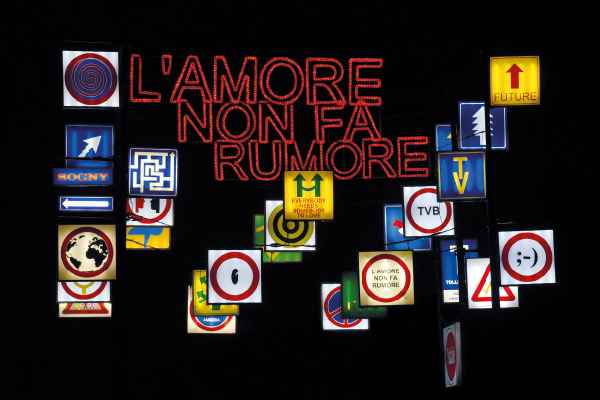
Ph. Lina Campanelli
Txt. Silvia Maria Sara Cammarata -
22
Amare le differenze (2005)
Michelangelo Pistoletto
Antica Tettoia dell’Orologio, Porta Palazzo (Circ. 7)
Neon, supporting frames and control systems.
DISCOVER
Amare le differenze (Loving Differences) is the phrase translated into 39 languages that appears on the city’s most important food market in the multi-ethnic Porta Palazzo district. In Pistoletto’s thinking, differences, which are often the reason for social conflicts, are also the aspect to be valorised in order to resist a system that tends towards standardisation. His urge therefore goes beyond the usual categories of tolerance and inclusion and “penetrates directly into the sphere of feeling.”
The work is part of Love Difference – Movimento Artistico per una Politica InterMediterranea of Cittadellarte’s Policy Bureau, which “unites the universality of art with the idea of political transnationality and focuses its activity on the Mediterranean area as it reflects the problems of global society.” Love Difference is in keeping with Pistoletto’s path and in particular with the 1994 Progetto Arte manifesto and the creation of Cittadellarte, a Biella-based foundation established in 1998 to “inspire and produce responsible change in society through creative ideas and projects.”
The social vocation of the Amare le differenze light is enhanced by the context of Porta Palazzo, a working-class neighbourhood, a real crossroads of people and goods from different countries.
Pistoletto made his debut in the late 1950s, to gain critical attention shortly afterwards with Quadri specchianti. One of the protagonists of Arte Povera, he created works that became symbols of an entire artistic season such as the Venere degli stracci (Venus of rags) or of the protest against the art system itself such as Oggetti in meno (Minus objects) (both 1967), and since then the involvement of the viewer has been one of the central themes of his work. At the Venice Biennale he was awarded the Golden Lion for Lifetime Achievement. Since 2004, he started the Third Paradise project.
Ph. Marco Briola
Txt. Silvia Maria Sara Cammarata -
23
My Noon (2010)
Tobias Rehberger
Piazza Arbarello (Circ. 1)
Steel and LED flex neon, steel base covered in stone, computer control unit.
DISCOVER
With My Noon, Tobias Rehberger has created a clock made up of luminous elements such as white circles, red inclined lines and white vertical lines that correspond to hours, fractions of ten minutes and minutes respectively. By counting the lit elements, it is therefore possible to know the time.
Since his beginnings in the 1990s, Rehberger’s research has addressed the themes of perception and awareness, temporality and the sense of transience, discontinuity and ambiguity. The work in Torino takes the form of a conceptual work on the perception of time, further enhanced, in the artist’s intentions, by its placement near historical buildings or monuments.
One of the most successful German artists of his generation, Rehberger trained at the Städelschule in Frankfurt, where he now teaches. He has experimented with different expressive languages, from sculpture to video, from wall painting to installation, and has exhibited in prestigious venues such as the Whitechapel Gallery in London, the Stedelijk Museum in Amsterdam, the Museum Ludwig in Cologne or the Museo Nacional Centro de Arte Reina Sofia in Madrid. He has often distinguished himself for an ironic and desecrating reinterpretation of the modernist paradigm, to which he remains attached to a certain extent. Some of his installations such as Was du liebst, bringt dich auch zum Weinen (What you love also makes you cry), a work in the form of a social space, the Cafeteria in the Central Pavilion of the Venice Biennale, still in use today, which earned him the Golden Lion at the 2009 Biennale, refer to the world of the historical avant-garde.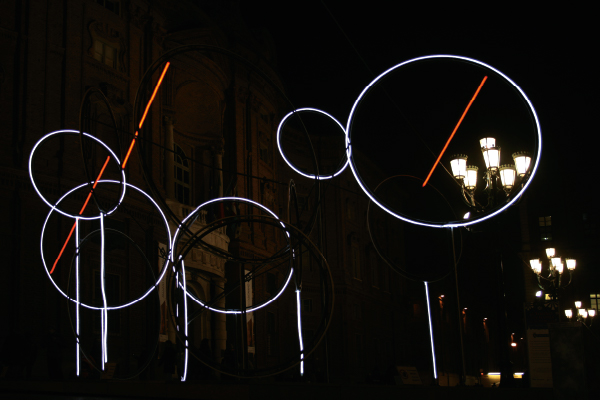
Ph. Rita De Nardi
Txt. Silvia Maria Sara Cammarata -
24
Ice Cream Light (2013)
Vanessa Safavi
Via Borgo Dora (Circ. 7)
Neon and aluminium frame.
DISCOVER
Ice Cream Light consists of over fifty neon rectangles depicting as many ice cream cones. Different, yet similar to each other, they were modelled on the illuminated signs of ice cream parlours. Vanessa Safavi used them as catalysts for some positive stereotypes linked to the image of Italy and its flair as a land of good food, good taste and pleasure.
The artist explained how important it is for her to belong to a culture such as Switzerland, which includes three languages and thus puts her in touch, from her point of view, with an inherently multiple identity. Her research into population movements, tourism and the notion of exoticism led her to travel extensively, especially to Africa, and to address issues of otherness and alienation.
In 2011, Safavi won the Illy Present Future Prize with her installation Real Life is Elsewhere, later exhibited at the Castle of Rivoli, in which, with the use of sand, she evoked the boundless spaces of the desert.
The following year saw her first installations with small, coloured taxidermied birds, the result of her reflections on transience, while more recent are the silicone works such as Alien Armpit (2022) or those in which she addresses issues of gender identity such as Various Diaries of Women’s Empowerment (2021). Her most recent works, for which she employs a variety of different materials, are often characterised by her choice of pastel colours and scratchy titles, such as Ecstasy Entropy (Prozac) or Housewife on Drugs (Lexo), both from 2021.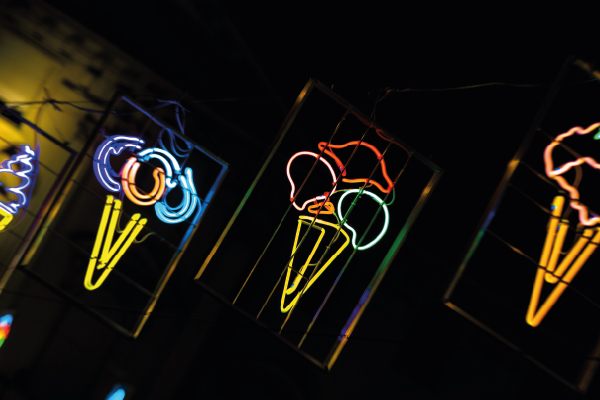
Ph. Riccardo Rebora
Txt. Silvia Maria Sara Cammarata -
25
Noi (1998)
Luigi Stoisa
Via Po (Circ. 1)
Neon replaced with LED neon flex in 2022, steel profile, aluminium profile, steel and nylon cables.
DISCOVER
Luigi Stoisa’s installation consists of the succession of 15 pairs formed by the profiles of a man and a woman that join at head height, as if forming the gable of a hut. The Christmas theme is played out at its core: “I wanted to work on man, after all Christmas is a creation of man and woman.” Even the choice of monochrome colouring dilutes the festive reference to evoke rather a feeling of warmth, protection, and the values of unity, sharing and, basically, love.
Fascinated by the transformation of materials, Stoisa’s research ranges from painting to terracotta and bronze sculpture, from polymateric installations to drawing, which he considers the “first form of the idea.”
Luigi Stoisa had his first solo exhibition in 1984 at the Torino gallery Tucci Russo, where he exhibited Narciso, an installation with tar and painting, in which the reinterpretation of process instances is combined with a reflection on the recent return to figuration. Since then he has been the protagonist of important national and international exhibitions at institutions such as the Fundación Joan Miró in Barcelona (1985), the De Appel Foundation in Amsterdam (1986), the Museum of Contemporary Art Luigi Pecci in Prato (1988) and many others. In addition to the Noi (Us) light, he has realised several urban interventions in Torino, including the installation for the AISM in 2004, the bronze sculptures for the Italo Calvino Library in 2008, and the creation of the Holy Door for the Duomo in 2015.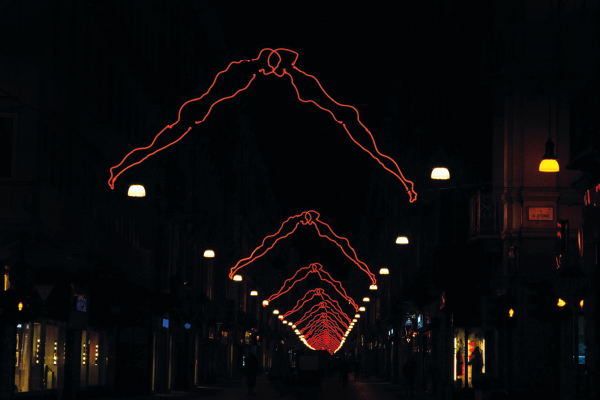
Ph. Paolo Caprioglio
Txt. Silvia Maria Sara Cammarata -
26
… ? … (2022)
Grazia Toderi
Cupola della Basilica Mauriziana, piazza della Repubblica (Circ. 1)
16 led projectors, DMX control system, aluminium, steel cables.
DISCOVER
“Piazza della Repubblica is bright, full of points of light that draw the frenetic activity of this place. I wondered what sense a work of mine could make in this space, and at one point I felt the presence of an architectural body observing the square from above. It was the dome of a church that remained in a dark upper plane, different from the lower one that determined all the activities of the city.” The Basilica Mauriziana is located near the square where one of Europe’s largest markets takes place every day, a place of exchange and relations in the heart of the city, in a neighbourhood that has grown over the years, strengthening its multicultural identity. Emerging in the darkness above the dome is the work ...?... by Grazia Toderi: a red question mark, which is not motionless but changes thanks to an animation programme of lights, which make it alive and always different, as if it were renewed at every glance. From the top of the Basilica, the work ...?... seems to silently observe the bustle of daily life that pervades the square, like an open invitation to ask questions without necessarily arriving at a single answer. It is a sign that poetically intends to show the value of doubt and hesitation in the face of the complexity of reality. Iconographic reference already present in other works by the artist such as Quoi? (2003), the question mark is intended to symbolise common personal and shared questions concerning everyday life, and also to show how continuous doubt is the driving force behind the desire for knowledge and research, which is applied in the scientific, political, spiritual, artistic and cultural fields.
Through video, photography, drawing and light, the works of Grazia Toderi offer a reflection that combines intimate and personal visions with a collective imagination in dialogue with the evolution of technological language and contemporary media culture. In her video works, light and movement appear on layered traces of cities and architecture, connecting earth and sky. Grazia Toderi has exhibited in major international institutions, receiving numerous awards, including the Golden Lion at the Venice Biennale in 1999.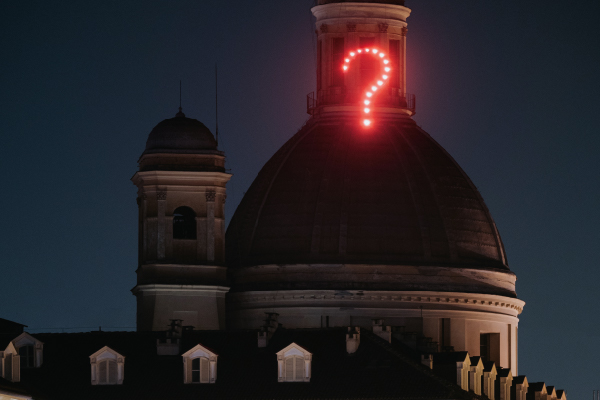
Ph. Federico Masini
Txt. Davide Quadrio -
27
Luce Fontana Ruota (1999)
Gilberto Zorio
Corso Unità d’Italia presso il Laghetto di Italia ‘61 (Circ. 8)
Steel supporting structure, light starshaped steel mill, buckets, plastic tubes, phosphorus and plastic material painting, control panel.
DISCOVER
Gilberto Zorio’s Luce Fontana Ruota (Wheel Fountain Light) is a five-pointed star over eleven metres in diameter, which, supported by a vertical arm, rotates like a mill, skimming the surface of the water and thus generating small, continuous waterfalls. Covered in phosphorus, the work takes on a close to light blue colour.
The figure of the star is perhaps the most recurrent in Zorio’s work: in crystal, in leather, with glowing nickel-chrome outlines, composed of javelins, or in the form of a brick turret with a five-pointed section, it runs through the artist’s entire career. And phosphor had already been used on several occasions, starting with the phosphorescent wax Fist exhibited at Sperone in 1971 and in Kassel in 1972. Zorio’s work is characterised by the use of industrial materials that, as they transform, become carriers of latent energies and tensions. The condition of darkness or light, the evaporation of seawater (in Tenda, 1967) or chemical reactions (Piombi, 1968) make processuality its hallmark. One of the protagonists of Arte Povera, since the mid-sixties Zorio began an intense exhibition activity that brought his works to some of the most important international institutions and to five editions of the Venice Biennale.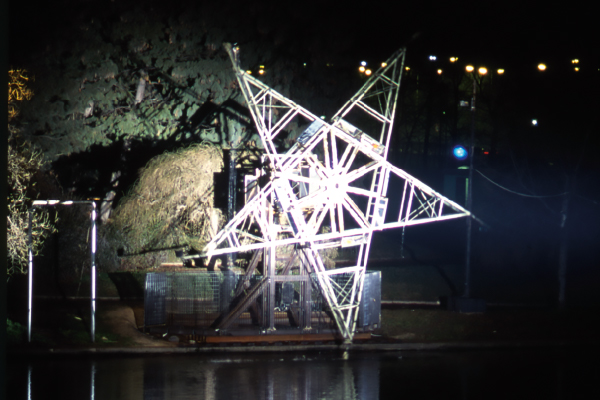
Txt. Silvia Maria Sara Cammarata -
A
Guizzo Baleno
Mario Airò
Via Baltea (Circ. 6)
Conceived for the Laboratori di Barriera (Via Baltea 3, Turin), thanks to the Nuovi Committenti programme, the luminous sculpture was commissioned by the Associations that operate there. It is an aerial sign that suddenly changes direction and, like a wave, rewinds on itself, evoking the energetic force of the electric arc and the enchantment of a rainbow imprinted in the alchemy of matter.
DISCOVER -
B
madre
Alessandro Bulgini
Flashback Habitat Ecosistema per le Culture Contemporanee (Circ. 8)
The artwork is connected to the history of the place where Flashback operates, the former Provincial Institute for Children in Turin. For the artist, the walls of the 4 buildings have a greater value than one might think, so much so that they symbolically become Mother themselves. It is among the walls of the orphanage that, in the moment of abandonment, an original bond was broken. The work is accompanied by a text recounting the testimony of those who inhabited that place.
DISCOVER -
C
Visual Persuasion
Paulina Olowska
Fondazione Sandretto Re Rebaudengo (Circ. 3)
Visual Persuasion is a light installation composed of seven neon signs placed along the darkened gallery of the museum, thus recalling the urban and nocturnal dimension, in a game of cross-references between inside and outside. The artist's idea is to bring the city into the building, the neon corners of the alleys into the halls, to experiment with the effect of images on the subconscious and the creation of desire. The reflection on the memory of the city is presented with a symbolic universe in which consumerism, feminism and design intersect.
DISCOVER
For information on times and tickets fsrr.org -
D
MOSADEQHShadi Harouni
Mao - Museo d’Arte Orientale (Circ. 1)
The artwork evokes the store sign of Reza Nik, a shoemaker in a provincial town in Iran. Written in Farsi, it spells out the name of Mohammad Mossadeq - prime minister freely elected by the Iranian people, then dismissed through a CIA-organized coup - MSDQ. Shortly thereafter the authorities ordered it to be changed. By removing the first letter, the sign turned the name into truth, but after a few years the "S" also died out remaining Deqh, or death by heartbreak. MOSADEQH reports the psychological and emotional repercussions of the coup. Neon intermittently turns on and off in some of its parts to simultaneously scan the name of the late prime minister and the Farsi-language term for death by heartbreak.
DISCOVER
For information on times and tickets maotorino.it -
E
Emanuela Ascari
Miraflora
Teatro della Parrocchia della Visitazione di Maria Vergine e S. Barnaba. (Circ. 2)
This luminaria proposes a "reconversion" of the imagery associated to the name of the Mirafiori district, changing it to MIRAFLORA, in reference to the ancient Miraflores Castle from which it took its name.
DISCOVER
The work is the winner of the Urrà competition, which included an artist residency with one of the families who live in the "tower houses" of Via Artom in Mirafiori south, a public housing complex built in the late 1960s to provide a home to the new citizens who arrived in Turin to work at Fiat. Due to the Covid19 pandemic, the artist, inspired by Luci d'Artista, thought of a work that could be hosted in her place and be activated by the inhabitants. The luminaria presents a reinterpretation and a new narrative of a quarter with a high density of "green", a district where people live well, breathe, where there is oxygen. -
F
In this issue: Statement concerning the Institutional history of the museum
Khalil Rabah
Fondazione Merz (Circ.3)
This installation is among the works of the archival part of the Palestinian Museum of Natural History and Humankind. It echoes the title of a museum newsletter and allows for a reflection on how works about the museum can also create an anatomy of the museum itself, which seeks its place and grows by asking: can art correct history?
DISCOVER
For information on times and tickets
fondazionemerz.org -
G
Internet Vittoriano
David Reimondo
Corte Palazzo Cisterna (Circ.1)
The research of the artist is based on the role of language within our society, and using the Morse code, he focuses on the aesthetic and artistic element that such idiom contains. The multimedia installation acts on several levels: spatial, temporal and sensory. The light installation, also accompanied by a soundtrack, reaches its maximum usability at sunset when it transforms the space into a stage that the viewer can walk through and experience from the inside and visit during the day.
DISCOVER -
H
Giardino Barocco Verticale
Richi Ferrero
The number 6 / Via Alfieri, 6 (Circ. 1)
"(…) [The Vertical Baroque Garden] arises from the desire to reinterpret the presence of the original baroque garden as an evocation of the 'oneiric space', a moment of refined and rigorous decoration of the common area. The original place does not exist and can no longer exist, but its memory is reborn today, in the verticality that rises from the court to the roofs to live as a garden-evocation suspended in the air. (...) making use of the lightness of the light emissions, it brings back to mind what was the hallmark of the common areas.”
DISCOVER -
J
L’albero del PAV
Piero Gilardi
Via Giordano Bruno, 31 (Circ. 1)
This tree, adorned with colorful arabesque lights, intends to become an auspicious symbolic prelude for the citizens who will adventure to enter the PAV (Living Art Park), amidst fragrant green bushes, in search of the signs of an ecological art that celebrates our fascination for nature.
DISCOVER
Pav, Parco arte vivente -
K
a-cromative
Migliore+Servetto for GRATTACIELO INTESA SANPAOLO
Grattacielo Intesa Sanpaolo (Circ. 3)
The site-specific light installation designed by Migliore+Servetto for the Intesa Sanpaolo Skyscraper: a dynamic work, bursting with a wave of colours constantly changing with the light. Like stop motion frames, light flakes line up to generate a pulsating organism perfectly integrated into the nature of the bioclimatic greenhouse: a breathing, iridescent vortex that vibrates in harmony with the wind and the surrounding environment, adapting to natural light and transforming in the darkness.
DISCOVER -
L
Sintesi ‘59
Armando Testa
Piazza XVIII Dicembre (Circ. 1)
Sintesi ’59, a sphere and a half of black steel about 5 metres high, is Turin’s way of remembering Armando Testa, one of the greatest of all Italian creatives, a leading light in contemporary visual culture and creator of symbols that have become part of our collective imagination.
DISCOVER -
M
Luce in cattedra
Polito in Light
Castello del Valentino, Corte D’Onore (Circ.1)
Professor Light is a temporary light art installation designed for the main courtyard of the Valentino Castle. The idea of the academic vocation of the courtyard takes form here, represented by a luminous tree, a symbol of knowledge, and twelve cubes arranged in a radial pattern. Light becomes a tool able to create a perceptive experience: the dematerialization of the tree is opposed to the ephemeral solidity of
DISCOVER
the cubes, and the static nature of the tree contrasts with the dynamism given by the continuous chromatic change of the cubes. Edited by IREN.
-
N
1706
Luigi Nervo
Intersection between via Pianezza and via Foglizzo (Circ. 5)
A sculpture-monument in stainless steel made in 2006 to celebrate the 300th anniversary of the siege of Turin. The work bears the date of this historic event (1706). Nervo called the project “a vibration of forms that manifest as unfolding matter. Matter that is unleashed and arises from the cracks in the earth, first become a number and then a sign-symbol that can evoke and narrate in the sequence: matter-sign- story.”
DISCOVER -
O
Anatomia Umana
Salvatore Astore
Corso Galileo Ferraris
A permanent site-specific art installation in stainless steel, over 5 meters tall, made to commemorate the 500th anniversary of Leonardo da Vinci’s death. Composed of two vertical bodies bearing evident signs of welding on the surface and characterized by two large holes in the shape of a skullcap, the work Anatomia Umana harmoniously interacts with the surrounding environment, enhancing different views of the city. It was donated by the Galleria Mazzoleni to the City of Torino.
DISCOVER -
P
Flammarion
Oliviero Rinaldi
Italgas, Largo Regio Parco (Circ. 7)
In its installation across the city, Flammarion is inspired by the concept of the constellations as groups of celestial bodies scattered across space with a recognizable geometric pattern, studied and divulged in the late 1800s by the astronomer Camille Flammarion.
DISCOVER -
Q
L’albero orizzontale di Piazza Montale
Tavolo Vallette
Piazza Eugenio Montale (Circ. 5)
A participatory project carried out by Tavolo Vallette in collaboration with Casa di Quartiere and Officine Caos of the District 5 and IREN.
DISCOVER -
R
Mondlader
Marco Lodola
Mercato Centrale – piazza della Repubblica (circ. 7)
A perpetually moving human blue wave, crossing the desert and the sea in search of a better life. Mondlader is inspired by the song of the same name by Roberto Vecchioni and the film by Matteo Garrone, Io Capitano.
DISCOVER
Made with the contribution of Cultura Italiae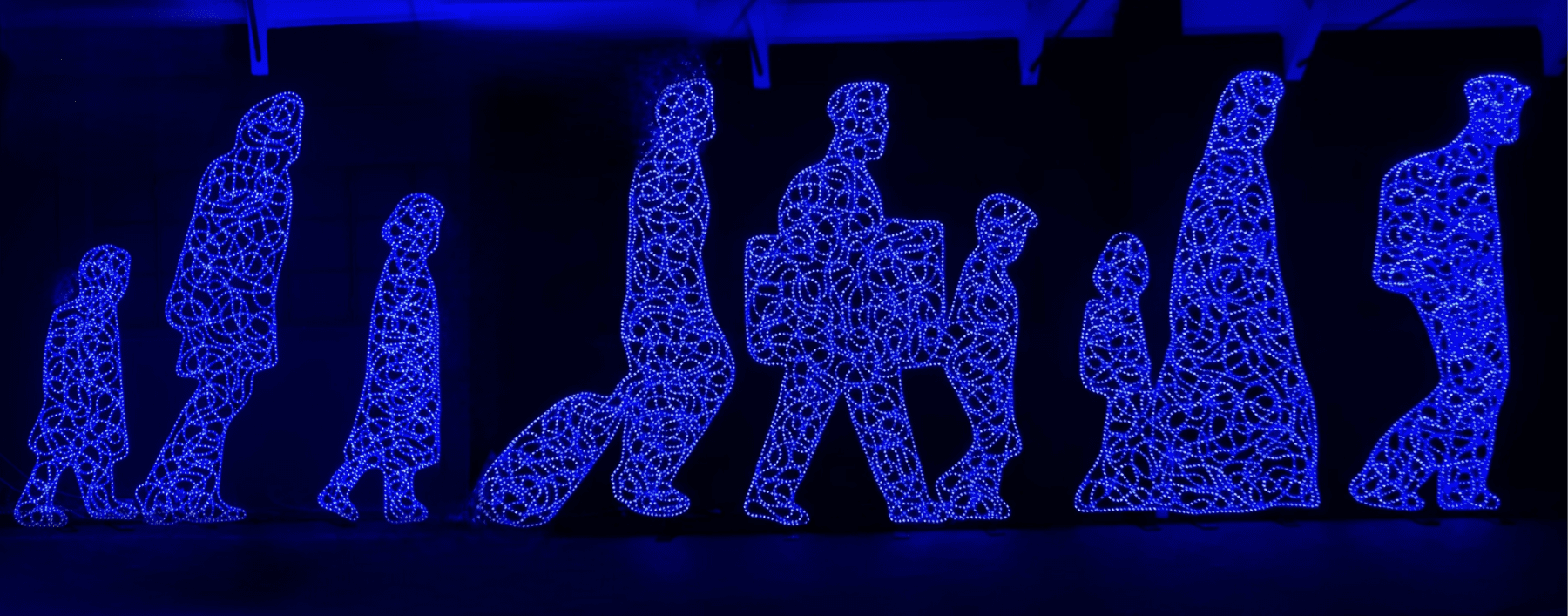

-
ACCADEMIA DELLA LUCE
The Luci d'Artista Public Program
The Public Program, renamed Accademia della Luce (Academy of Light), plays a fundamental role in this evolutionary path; a path of initiatives and activities that integrate and accompany the light installations on the city's territory. The Public Program will be coordinated by the Luci d'Artista curator and will have a unique theme: this year the theme is "Light and the Poetic Word", around which all the activities will revolve.
Within the framework of the Academy of Light, six museums in Turin - Castello di Rivoli Museo d'Arte Contemporanea, Fondazione Merz, Fondazione Sandretto Re Rebaudengo, GAM - Galleria Civica di Arte Moderna e Contemporanea, MAO Museo d'Arte Orientale and PAV Parco Arte Vivente - thanks to their Education Departments will promote opportunities for debate and actions with schools in the territory, bringing Luci and contemporary art closer to classical education, becoming the protagonists of targeted educational proposals for all of Turin's districts.
Public events, on the other hand, will be concentrated in the days around 21 (summer solstice) and 24 June 2024 (Saint John the Baptist, patron saint of the City of Turin). This will be Luci d'Artista's first big step out of its usual temporal confines; on this occasion a group of poets, both Italian and foreign, from different generations, will be involved, invited to work on the theme of light through performances and readings. But already in December 2023 the activities will begin with a conference on the work and work of the author of the new Light, Giovanni Anselmo, in the spaces of the GAM, in which critics, art historians, artists and gallerists who have crossed paths with the master of Arte Povera will be involved. -
LUCI D'ARTISTA CITY TOUR
Enjoy Turin in extraordinary light on a very special city tour
Led by a tour-guide you can experience the wonderful installations of the 26th edition of LUCI D’ARTISTA during an impressive one-hour tour with the double-decker City Sightseeing® Torino bus.
When: Saturday 4th, Saturday 11nd, Saturday 18th and Saturday 25th November 2023 and every Saturday and Sunday from 2nd December 2022 to 7th January 2024 + 8th, 25th e 26th December 2023 and 1st January 2024
Departure: 5,30 pm* (piazza Castello/via Po)
*8th, 9th, 30th December 2023 + 6th January 2024 5.30 pm and 7 pm
Adult: € 18,00
Child (5-15): € 9,00
Child under 5: Free
Info and reservation:
City Sightseeing
infotorino@city-sightseeing.it
Tel: +39 011 19464500
RENT YOUR BUS
Whether you are planning a visit for your company or your private group, a tour led by a knowledgeable guide is a great way to discover the LUCI D’ARTISTA installations -
URBAN TREKKING
“NATURE IN THE CITY UNDER LUCI D'ARTISTA”4 URBAN TREKKING ITINERARIES COMBINING NATURE AND ARTISTIC LIGHTS – IN COLLABORATION WITH METROTRAIL
An environmental hiking guide will accompany visitors to discover ecologically relevant environments in Torino - such as rivers, parks, gardens and simple flowerbeds - along unsual green urban paths, punctuated by LUCI D'ARTISTA installations. The silent nocturnal fauna of the rivers will contrast with the lights themselves and the life of the city; monumental trees and secret gardens will mark Nature's revenge on the metropolis.
The walks will be approximately 6 to 7 kilometers long and will last approximately 2h30. They are scheduled for Saturday 4th (5.30 pm); Friday 10th (8.30pm) and Sunday 19th November (5.30pm); Saturday 2nd (5.30 pm), Wednesday 6th (8.30 pm); Wednesday 27th December (8.30 pm) and Friday 12th January 2024 (8.30 pm)
The routes last a maximum of 2h30.
Adult: € 16,00 / Child (5-15): € 8,00 / Child under 5: Free
Minimum 4 people.
The trekking will be done in Italian; Spanish and English on request
Info and reservation:
www.metrotrail.it/luci-dartista
info@metrotrail.it
Tel: +39 342 7530853 (WhatsApp too)
Discover the itineraries download -
DISCOVERING TORINO
TORINO+PIEMONTE CARD
For a period ranging from 1 to 5 days, free admission to major cultural sites, the Royal Residences of Turin and Piedmont, museums and foundations dedicated to all types of art: from ancient to modern and contemporary. Discounts on the city's tourist services and reductions on many activities. Starting from 29.00 € and also available in the Junior version from 18.00 €, for under 18s.
Info at the link
MERENDA REALE
An unmissable chance to taste the original recipe for hot chocolate from 18th-century courts or the famous 19th-century bicerin in the setting of the renowned historic cafés of Torino.
Info at the link
EXTRA VERMOUTH
A tasting experience of _Torino’s most famous aromatized wine , accompanied by the traditional gastronomic specialties of Piemonte’s “merenda sinoira”
Info at the link
